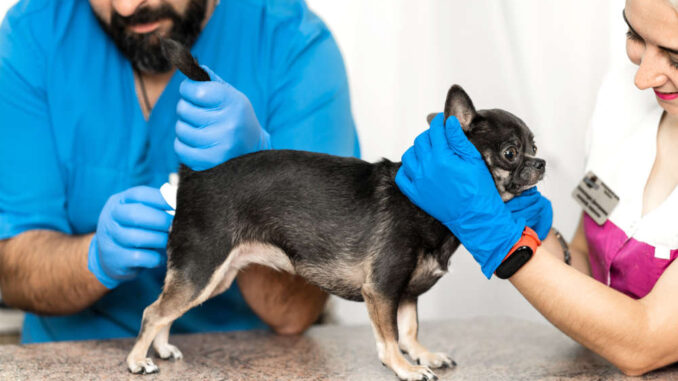
This article was updated on August 26th, 2023
One of the pet patients I recently treated for anal gland issues came to the clinic because he was bleeding from around the anus. As I spoke with the owner, I learned the pooch had been licking his rear end a lot and was scooting on the floor. My examination confirmed my suspicions of an anal gland abscess.
When you notice bleeding from your dog’s anal glands, chances are the sacs are either infected/abscessed or ruptured. In this article, we’ll talk about bleeding anal glands in dogs, how to recognize the condition, and what to do when you notice trouble. We’ll review the causes of bleeding anal glands and when it’s time to visit your vet. So you know what to expect, I’ll explain the treatment options and likely costs.
Overview of bleeding anal glands in dogs
Dogs have glands on either side of their anus that usually secrete a pungent liquid during defecation. The fluid lubricates the feces, marks territory, and leaves scent-based messages for other dogs.
Sometimes, the glands don’t empty properly, so they fill up with liquid. Over time, the sacs may become infected or rupture, leading to drainage and bleeding. If your dog’s anal sacs are bleeding, it’s a symptom of an underlying condition that needs veterinary assistance.
Early symptoms of bleeding anal glands in dogs
Dogs frequently show symptoms of a problem before the glands start bleeding. Early-stage signs can include:
- Scooting on the floor
- Licking or biting at the anus
- Straining or pain during defecation
- Streaks of blood on the stool
- Soft or squishy stool
These symptoms surface when the sacs become clogged. If they’re not addressed, bacteria can get into the glands and trigger an infection. At this point, you may also see swelling, redness, or an abscess.
What to do when your dog’s anal glands start bleeding
Once the glands become infected, they can become abscessed or may rupture. Bleeding from the glands occurs with either condition. When you notice your dog’s anal glands are bleeding:
- Contact your veterinarian to schedule an appointment
- Gently wipe off the blood using a clean, damp cloth
- Prevent your dog from licking or biting at the anus – use an e-collar if needed
- Discourage scooting behavior
- If your dog has an infection or abscess, apply a warm compress to the area
- Lay clean towels down where your dog rests or sleeps
Causes of bleeding in dog anal glands
There are three possible causes of bleeding in your dog’s anal glands.
Infection or abscess
When bacteria find their way into the anal sacs, they cause an infection. As the microorganisms grow, pus builds up in the gland causing swelling and pain. Signs of infected or abscessed anal glands include:
- Straining and pain during defecation
- A red, hot swelling spot near the anus
- Discoloration around the anus
- Scooting
- Quickly turning around to look at the butt
- Lack of energy
- Bleeding around the anus
Anal gland abscesses/infections respond well to veterinary care and have a good prognosis when they receive treatment. At the clinic, your vet will:
- Lance and drain intact abscesses
- Flush the anal gland to remove pus/infection
- Prescribe a course of antibiotics for 10-14 days
- Prescribe antiinflammatories or pain medication
At home, you can apply warm compresses to ease inflammation and discomfort. You should also keep the area around the anus clean by wiping it with a clean cloth after your furbaby goes to the bathroom.
Anal Gland Rupture
Anal gland issues generally progress from an impaction to infection/abscess to eventual rupture. When the fluid and pus build up inside the sac, the pressure eventually causes it to burst open. Symptoms of a ruptured anal gland include:
- Swelling around the anus with purple discoloration immediately before the rupture occurs
- An open wound around the anus after the rupture occurs
Picture: you can view this picture of an anal gland rupture on the Canine Journal website.
- A fishy odor
- Blood and brownish-yellow or greenish pus around the anus
- Pain during defecation is significantly lower than before the abscess ruptured
- Licking around the anus
- Scooting
Like abscesses and infections, ruptured anal glands require veterinary care to prevent a recurring condition. The veterinarian will check the wound and drain any residual pus. If there’s an intact abscess he’ll lance and drain it. Then, he’ll flush the cavity and prescribe antibiotics and pain medications.
Ruptured anal glands have a good prognosis for recovery with treatment. It generally takes about 10-14 days for the wound to heal, but your dog will likely start feeling and acting normal in about 3-4 days.
Anal Gland Tumor
Occasionally, dogs will develop a cancerous adenocarcinoma of the anal gland. Older female canines are most likely to get this type of cancer Fortunately, it’s not common. Symptoms include:
- Bloody stool or blood around the anus
- Swollen hind legs
- Enlarged anal glands
- Increased thirst and urination
- Vomiting
- Lethargy
If your dog has an anal gland tumor, the vet will need to determine if the cancer has spread to regional lymph nodes. Treatment may include surgical removal of the gland, chemotherapy, or radiation treatment depending on the stage of the cancer.
When should I seek veterinary assistance?
Anal glands that become infected or rupture need to be seen by a vet. Schedule an appointment with your veterinarian if your dog shows symptoms like:
- Scooting
- Turning to lick the rear
- Red or red-purple swelling around the anus
- An open wound around the anus
- Blood/pus around the anus or on the stool
- Excessive licking around the anus
Treatment options and likely costs
The treatment your veterinarian recommends will depend on the cause of the anal gland bleeding.
Anal gland infection/abscess with or without rupture
Treatment includes
- Draining and flushing the infection – The approximate cost is $100 if there are no complications.
- Prescribing antibiotics – A 10-14 day course of antibiotics and pain medications will run about $50-75
- Anal gland removal – If the infection is severe or recurring, your veterinarian may surgically remove the anal glands. Depending on the severity of the infection and how much tissue is involved, the cost of blood screening, anesthesia, surgery, and follow-up treatments is about $1000-2000.
Anal gland tumor
The recommended treatment for anal gland cancer is surgical removal. As listed above, the cost for the surgery and related tests/supportive care is about $1000-2000. Because adenocarcinomas often metastasize, your dog will probably also require radiation treatments or chemotherapy. This will increase the total cost of treatment to around $5000.
What can you do to prevent bleeding from happening again in the future?
Your best chance of preventing bleeding in the future is by supporting healthy digestion and natural anal gland expression in your dog. Some things you can try at home include:
- Feeding a high-fiber diet that encourages firm stools
- Give your dog healthy high-fiber treats like pieces of apple or bite-size chunks of carrots
- Add high-fiber food to your dog’s meals – try 1 tablespoon of plain canned pumpkin per 10 pounds body weight
- Feed your dog food that keeps him fit and trim to prevent fat buildup in the anus
- Schedule regular appointments for your veterinarian to check your dog’s anal glands and express them if necessary.
- Exercise your dog daily to encourage healthy digestion and regular bowel movements
Frequently asked questions
How long does it take bleeding anal glands to heal?
If your dog has an anal gland infection, abscess, or ruptured glands, it usually takes about 10-14 days to heal with treatment. Make sure to give your dog the full course of antibiotics prescribed by your veterinarian to completely knock out the bacteria.
Are all dogs prone to bleeding anal glands?
While any breed or age dog can have anal gland issues, some breeds are more prone to developing impactions, infections, and abscesses. Based on a 2021 cross-sectional study, smaller breeds have a higher risk of clogged and infected anal glands.
What can a veterinarian do to help with bleeding anal glands?
When you take your dog to the veterinarian for bleeding anal glands, he’ll examine your furbaby and decide on the appropriate treatment. Depending on the cause of the bleeding, the doctor may:
- Lance and drain abscesses
- Flush infected or ruptured glands
- Prescribe antibiotics to kill the bacteria and eliminate the infection
- Surgically remove severely infected or cancerous glands
Is surgery necessary for all cases of bleeding anal glands?
Many cases of bleeding anal glands can be managed with medical treatments. Early infections can be handled with manual expression, flushing, and a course of antibiotics. If the anal gland ruptures, the hole should be left open to permit drainage of fluid. Therefore, it’s usually severe or recurring cases of infection or anal gland tumors that require surgical correction.
Related posts:
Disclaimer: This website's content is not a substitute for veterinary care. Always consult with your veterinarian for healthcare decisions. Read More.








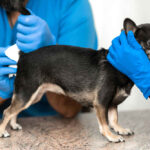

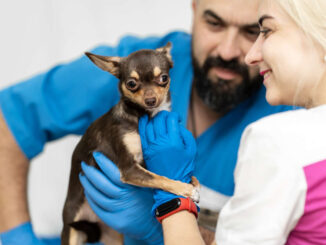
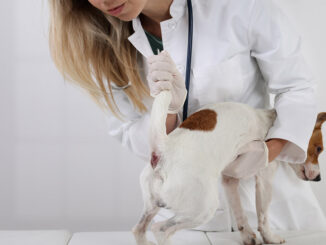
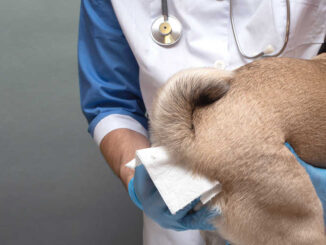
Be the first to comment